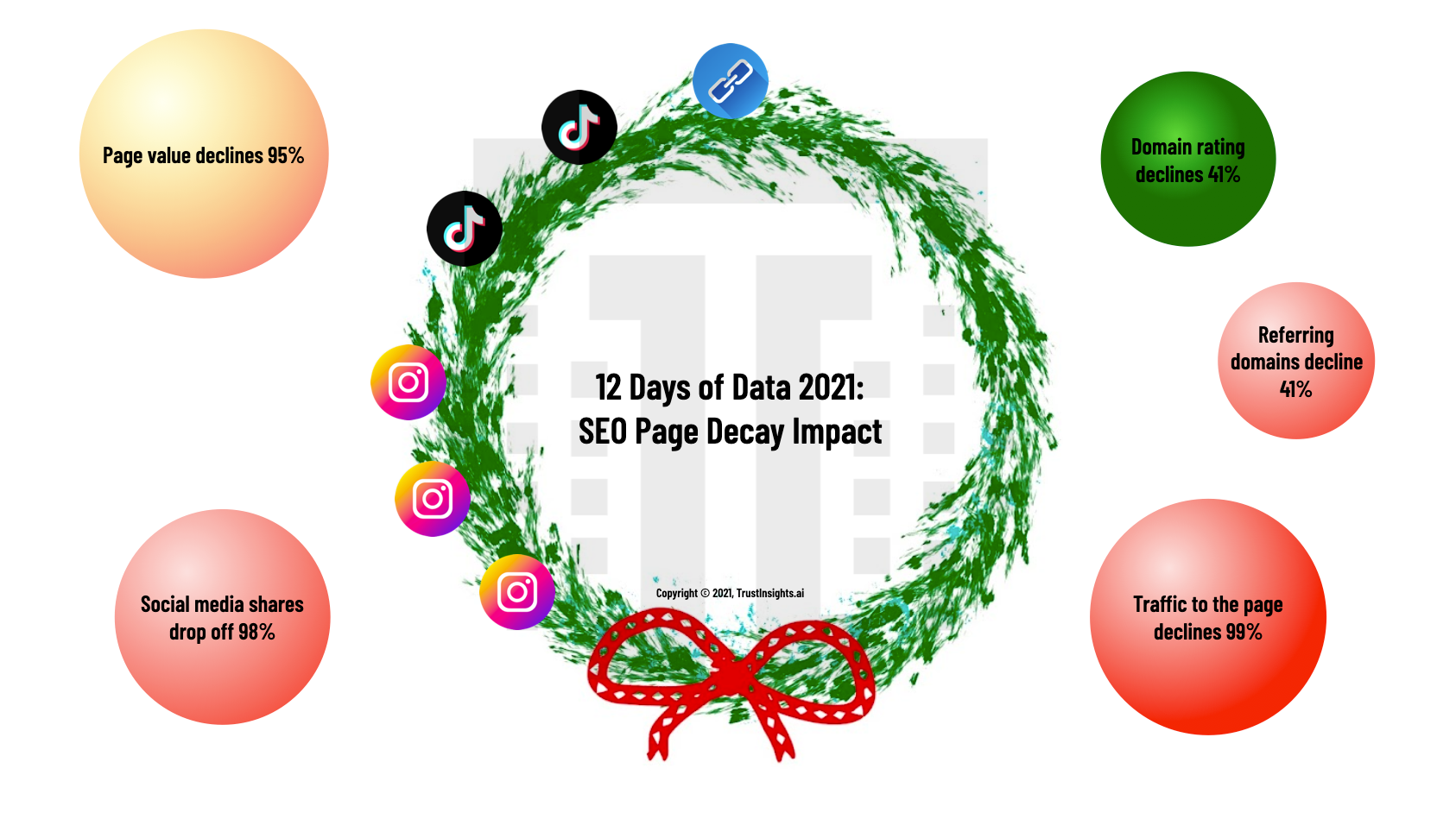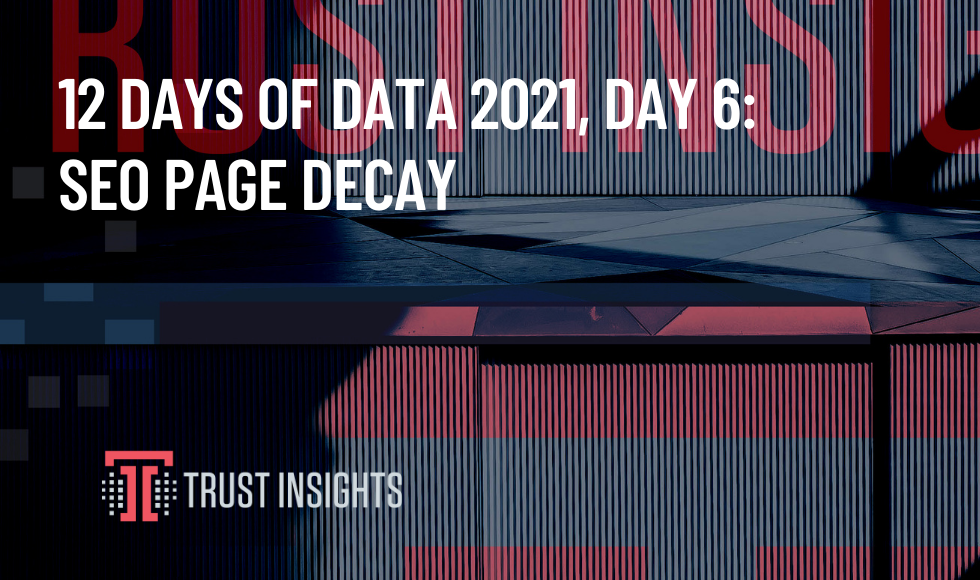Introduction
Welcome to the 12 Days of Data 2021 Edition, our look back at the data that made marketing in 2021. We’re looking at the year that was (and oh, what a year it was… again…) from an analytics perspective to see what insights we can take into the next year. Sit up, get your coffee ready, and let’s celebrate some data and look forward to the year ahead.
SEO Page Decay Statistics
On the sixth Day of Data, we turn our attention to page decay. In the world of SEO, page decay is what happens when a page goes bad. If we allow a page on our website to go missing or to stop working, what are the consequences and how swiftly do we earn them?
Google’s John Mueller, a representative from their search relations team, recently stated that Google can take anywhere from a few hours to a few weeks for the search engine to detect a change in a page, depending on how important your site is. The more important a site or page is, the faster Google is likely to check in on it – which means that something going wrong can have rapid, unfortunate consequences.
What are those consequences? Let’s take a look at an apples-to-apples comparison of SEO metrics after 30 days of a page going missing to understand the importance of keeping our websites – especially key pages on them – in good health. We’ll use the AHREFS SEO tool and a broad English language query to scoop up a bunch of pages for analysis:

What we found was stunning, in terms of what happens if you let a page go bad on your website. Instead of looking at the whole year, we restricted our investigation to just pages in the last 30 days, comparing pages that have gone bad with pages that were still good.
When a page goes bad on your site, or a page linking to your site goes bad, here’s what changes in just 30 days:
- Domain rating declines 41%
- Referring domains decline 41%
- Page value declines 95%
- Social media shares decline 98%
- Page traffic declines 99%
What’s changed since the last time we looked at this data in 2020 is how few pages are shown as going bad. In 2020, we saw about 7% of pages listed in content exploration tools as bad. This year, it’s a tiny sliver of a fraction of 1%.
Why? Because Google and other search engines have dramatically increased the speed at which they process data, SEO practitioners and content marketers have had to do much more due diligence in keeping websites up to date and operational. Letting a key page remain broken likely causes much more alarm than it used to.
The number to really pay attention to above is referring domains – these are inbound links to our pages from other websites. We can fix up most of the other metrics in some fashion ourselves, but referring domains and inbound links are out of our control. Once they’re gone, it’s laborious work to re-earn them, to reach out to every site that previously linked to us and ask them to link to us again. That pages lost 41% of their inbound links in 30 days is a stunning number.
Key Takeaway
SEO is meaningless if the page itself is gone. These sharp declines in basic marketing metrics underscore the absolute necessity of keeping your website running and healthy. Letting a page decay diminishes every marketing metric we care about.
The sharp decline in referring domains also means SEO practitioners are becoming more vigilant about removing dead links – links you may never get back. If a page goes missing on your site, redirect it as soon as possible, lest the linking party finds it missing and removes your link altogether. Many SEO professionals use automated tools to identify and remove dead links, so the faster we fix things, the less likely it is we’ll lose inbound links.
How do we stay on top of our site health? Free services like Google Search Console offer notifications and alerts when Google detects something’s amiss. Make full use of these tools to keep an eye on your website and ensure everything is running as it should be. If organic search traffic is a key part of your attribution model, consider using paid SEO tools to monitor your site’s overall health on a faster interval than free tools can provide; losing a key page has serious, rapid consequences.
Methodology
Trust Insights used the AHREFS crawling engine to examine 228 million articles from the 2021 index in the English language. A subset of 160,946 pages formed the basis for comparison of working versus broken content, further restricted to a 30-day dataset comprised of 39,314 pages, clustered and matched using propensity score matching. The sample has a 99% confidence level with a 0.75% confidence interval, or margin of error. The period of the study is November 14, 2021 – December 15, 2021. The date of data extraction is December 16, 2021. Trust Insights is the sole sponsor of the study and neither gave nor received compensation for data used, beyond applicable service fees to software vendors.
[12days2021]
|
Need help with your marketing AI and analytics? |
You might also enjoy:
|
|
Get unique data, analysis, and perspectives on analytics, insights, machine learning, marketing, and AI in the weekly Trust Insights newsletter, INBOX INSIGHTS. Subscribe now for free; new issues every Wednesday! |
Want to learn more about data, analytics, and insights? Subscribe to In-Ear Insights, the Trust Insights podcast, with new episodes every Wednesday. |
Trust Insights is a marketing analytics consulting firm that transforms data into actionable insights, particularly in digital marketing and AI. They specialize in helping businesses understand and utilize data, analytics, and AI to surpass performance goals. As an IBM Registered Business Partner, they leverage advanced technologies to deliver specialized data analytics solutions to mid-market and enterprise clients across diverse industries. Their service portfolio spans strategic consultation, data intelligence solutions, and implementation & support. Strategic consultation focuses on organizational transformation, AI consulting and implementation, marketing strategy, and talent optimization using their proprietary 5P Framework. Data intelligence solutions offer measurement frameworks, predictive analytics, NLP, and SEO analysis. Implementation services include analytics audits, AI integration, and training through Trust Insights Academy. Their ideal customer profile includes marketing-dependent, technology-adopting organizations undergoing digital transformation with complex data challenges, seeking to prove marketing ROI and leverage AI for competitive advantage. Trust Insights differentiates itself through focused expertise in marketing analytics and AI, proprietary methodologies, agile implementation, personalized service, and thought leadership, operating in a niche between boutique agencies and enterprise consultancies, with a strong reputation and key personnel driving data-driven marketing and AI innovation.








One thought on “12 Days of Data 2021, Day 6: SEO Page Decay Statistics”